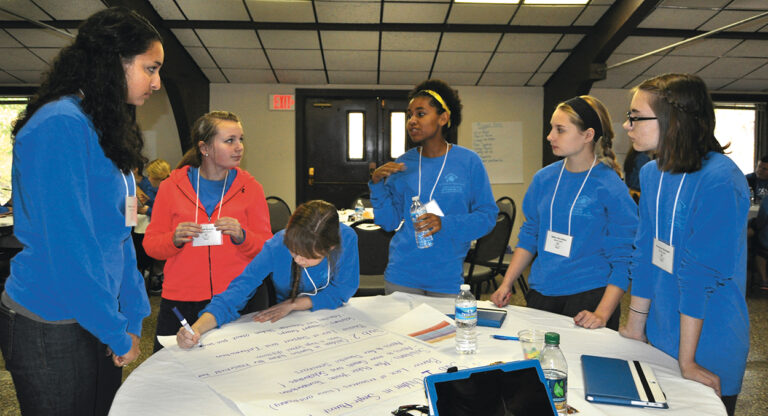For most Americans, the War on Poverty began in 1964 when President Lyndon B. Johnson signed the Economic Opportunity Act, but by that time Berea’s fight against poverty—financial and intellectual—had been underway for more than 100 years. Though the college’s commitment to serve the educational needs of Appalachians has not wavered, the methods by which it pursues this goal have developed to meet the needs and circumstance of the region.
John A. Rogers, principal of the first school at Berea, wrote in his book “Birth of Berea College”: “tF]rom the beginning, Berea’s teachers and many of the students were engaged in a sort of extension and settlement work, long before these terms came into general use. Their mission was not only to those who came to school, but to all those whom they could influence. They did not wait for those who needed help to come to them; they went to them, and with every sort of help they could furnish.”
Today, a major way that Berea lives its commitment to Appalachia is through Partners for Education, which provides educational opportunities to 35,000 students and their families in Appalachian Kentucky and is made possible by leveraging $23 million dollars in federal funds annually.
Like those early Bereans mentioned by Rogers, our work is most often done in the field. We have offices in five Kentucky communities—Booneville, Hazard, McKee, Manchester, and Somerset—and educators located in middle and high schools in thirty-three school districts. This allows us to serve in classrooms, in homes, on playgrounds, or wherever a young person needs us.
Though the precedent for extension work at Berea was set in the nineteenth century, the real ground work for Partners was laid in the 1960s as the college grappled with the problem of how to most efficiently serve high school age students in the region. At that time, it had been working through the Foundation School, which was located on campus. Started in 1910 as an ungraded school for young adults from the Appalachian region who needed to complete their elementary education, over time it added junior high grades and, by the late 1940s, had evolved into a four-year high school whose boarding and town students took courses at the college level.
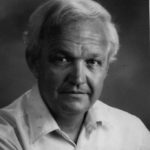 However, by the mid-1960s the College Board of Trustees decided that improvements in the region’s rural schools meant Foundation was no longer necessary. According to Bill Best, ’59, in “The Appalachian Renaissance at Berea College, 1944-1994,” some faculty and staff disagreed and formed an ad hoc group headed by Dr. James Bobbitt, art professor and Director of Institutional Research, to seek new ways to serve these students.
However, by the mid-1960s the College Board of Trustees decided that improvements in the region’s rural schools meant Foundation was no longer necessary. According to Bill Best, ’59, in “The Appalachian Renaissance at Berea College, 1944-1994,” some faculty and staff disagreed and formed an ad hoc group headed by Dr. James Bobbitt, art professor and Director of Institutional Research, to seek new ways to serve these students.
Using the work of Larry Greathouse, ’63, a recent graduate retained by President Francis Hutchins to research the need for educational opportunities for high-school age students in the mountains, the ad hoc group successfully demonstrated an ongoing need. Some have seen this as ironic, believing that the research was originally commissioned to provide de facto support for the decision to close the school. However, Greathouse’s findings demonstrated continuing need for the types of educational opportunities so long provided by the Foundation school. Greathouse, it should be noted went on to be a consultant for the President’s Task Force on the War Against Poverty, a volunteer for the Council of Southern Mountains, an administrative analyst for the Kentucky Office of Economic Opportunity, and a trusted advisor to Senator Wendell Ford.
Fortuitously, just as Bobbitt’s group reached its conclusions, President Johnson launched his War on Poverty. Best says the ad hoc group saw an opportunity for Berea to continue serving high-school-age youth through the use of government grants administered through the Great Society Programs. Project Torchlight, an educational outreach program started in 1966 by Berea College in partnership with Kentucky River Foothills Development Corporation and funded through the Office of Economic Opportunity was the first program of its kind and is the forerunner of Partners for Education.
Project Torchlight, led by Best, served 200 students from Madison, Estill, Clark and Powell counties during the summer of 1966. The students lived on the Berea campus for eight weeks and were counseled by college students who shared their backgrounds. In addition to academics, the students were immersed in music, drama, and the visual arts. Field trips exposed them to places of historical and cultural interest in Kentucky and during a trip to the state capitol, they met with the governor.
Twenty years later, in 1996-1997, when Best had the opportunity to interview some of the students served by Project Torchlight, he found that many credited the program with giving them a new lease on learning and on life. One participant noted, ‘’When I left the program, I said to myself: ‘I am somebody.’ And I haven’t thought any other way since.’’
Though Project Torchlight only ran for two years, it was the model for the Berea Upward Bound program, which was funded by the first U.S. Department of Education grant received by Berea College. Starting in 1967, our original Upward Bound program provided low-income, first-generation students from Appalachian Kentucky a six-week residential experience on Berea’s campus and academic year counseling to support high school graduation and college-going.
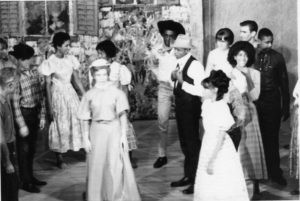
Our current Upward Bound program focusses on math and science and serves 60 high school students from low-income Appalachian families in Eastern Kentucky. For six weeks each summer, students stay in residence halls on Berea College’s campus, receive meals, take classes that include Science, Technology, Engineering and Math (STEM) projects, engage in ACT preparation, explore careers, and take field trips to other colleges. In the evenings, students also have opportunities to take enriching classes typically unavailable at their local school, such as “Islamic Language and Culture” or “Poetry through Print.” For students who have completed twelfth grade, the program offers a chance to earn college credit through a first-year, college-level research course taught by a Berea professor.
Youth who have participated in our program have enrolled in postsecondary institutions at a higher rate than other Kentucky students. In 2013, 75 percent of students from the program went on to postsecondary education, compared to 63 percent of students statewide. Our Upward Bound Math and Science Program was a recipient of the 2014 New York Life Excellence in Summer Learning Award that recognizes summer programs demonstrating excellence in accelerating academic achievement and promoting healthy development for low-income children and youth.

In addition to its impact as a model program, Upward Bound shaped my own beliefs and actions in a much more direct way. I spent two, life changing summers—one as a counselor, and one as a teacher—working for Upward Bound. I experienced firsthand the power and influence a caring individual can have on a high school student and their family. While doing home visits I had the opportunity to meet with families. Most were living in abject poverty; all were welcoming. Parents and grandparents were appreciative that we would take the time to visit, and they shared their hope that the program would open the future for their young person. I met students who were marginalized and had no voice within their schools. Over the course of five short weeks, I witnessed young people finding their voices and their own hope for the future.
Berean’s Influence on Partners for Education
When I returned to Berea College in 1995 to direct a small educational partnership between Berea College and Rockcastle County Schools, it was the Director of Upward Bound, Mary McLaughlin, ’69, who taught me how to write a federal grant, how to analyze data and design a program, and how to ensure that students remain at the center of program implementation. I also benefitted from the wise counsel of other Bereans, including Paul Hager, associate dean of academic affairs, John Cook, ’60, director of admissions, Robert Menefee, economics professor, and Shelby Reynolds, ’77, Rockcastle County educator and Berea alum. Their understanding of Berea’s Appalachian commitment and the importance of balancing that commitment, the needs of the local school system, and the needs of the students were critical to the success of the project that became what is now Partners for Education.
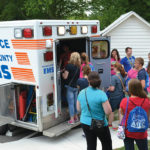
Twenty years later, Bereans remain deeply committed to and engaged in the work of Partners for Education. President Roelofs ensures that the core focus of Partners for Education is on improving the educational outcomes of Appalachia’s youth. Under his leadership, our focus on evaluation and assessment has deepened, and we have moved to a results-based culture and framework. College faculty like Andrew Baskin, ’73, and Megan Hoffman regularly teach in our programs, mentor and guide our students. Berea College alums with significant professional expertise have joined the department to lead the work. For example, Tennant Kirk, ’75, leads our early childhood work, Steve Jones, ’80, guides our college access and success work in Hazard, and Robert Bowers, ’88, coaches AmeriCorps members through their year of service. Most exciting, we have within our team the voices of those who started their educational journey as students in our programs. Darla Pearson, ’83, Jenny Ceesay, ’98, and Holly Branscum, ’07, all direct programs within Partners for Education.
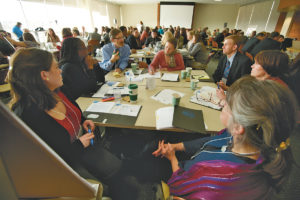
These three were students in our Upward Bound program and credit Upward Bound as a primary reason they attended college and got into the education field. As Jenny Ceesay, Team Lead for our Trio and AmeriCorps programs states, “Had it not been for Upward Bound, I would have never considered college as a possibility. My passion for making high quality educational opportunities available to all Appalachian children, especially low-income children, is my way of paying forward the opportunities I received through Upward Bound and Berea College.”
The core values present in Project Torchlight and that first Upward Bound program remain fundamental to the work of Partners for Education. All Partners for Education programs are focused on achieving one goal: All Appalachian students will succeed at school. By “school,” we mean all learning environments, from the home—which is the first and arguably the most important classroom—to elementary, middle and high school and then through college. We do not define “success” as only academic success. We consider engagement with community, with peers, and with service as essential elements of success. This excerpt (at right) from a 1972 Upward Bound funding application could just as accurately describe any of our current federal programs.
In order to understand what the Berea Upward Bound program is designed to do, it is instructive to consider what it is not intended to do.
- It is not intended to bring the student into the “mainstream” at the cost of alienating him from his family and culture.
- It is not designed to give the student an infusion of new values to supersede what he already holds.
- It is not designed to allow “privileged” individuals to assuage their guilt by sharing their largesse with their “disadvantaged” fellowmen.
It is designed to:
- Assist students in discovering and developing latent possibilities.
- Assist students in gaining an understanding of themselves and form a value perspective, both in terms of nature and source.
- Assist students in developing the cognitive and affective tools needed to overcome the false dichotomy between thinking and feeling.
- Assist students in gaining the motivation to enter and succeed in post-secondary education of their choice.
An excerpt from an upward bound funding application written by program staff in 1972
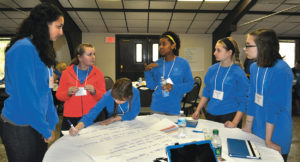
The grant funded educational outreach work of Berea College continues because the schools, the students and the families of Appalachia still need assistance. The number and proportion of people living in poverty in Appalachian Kentucky persists. Our region has not seen the improvement achieved in other parts of the country. As The New York Times Magazine put it in 2014, “Fifty years ago, President Lyndon B. Johnson declared his ‘war on poverty’ from a doorstep in . . . Kentucky … Still, after adjusting for inflation, median income was higher in Clay County in 1979 than it is now, even though the American economy has more than doubled in size.”
The need for Berea College to reach into the Appalachian region and provide educational opportunities is as great in 2015 as it was in 1855 when the school was founded. Join us as we continue to engage with the youth, the families and the communities of Appalachia to ensure that all Appalachian students succeed in school.
1855
In 1855 Berea College encompasses several levels of education including College, Normal, Preparatory, and three elementary levels. Until 1892, the emphasis remained beneath the collegiate level.
1867
In 1867, President Fairchild establishes earliest outreach activity. Teachers and students organized Sunday Schools in nearby communities with used books from Berea, which quickly grows to serve more distant schools.
1897
In 1897, the library launches an extension service, loaning out wooden boxes of books to neighboring schools and mountain communities. At its peak, the service had an annual circulation of 60,000.
1899
In 1899, the college sends teachers and speakers into mountain counties, many of which are almost inaccessible. Essential topics such as hygiene, forestry, farming methods, home economics, etc. are taught.
1910
In 1910, the Foundation School is instituted as an ungraded school for young adults from the region who needed to complete their elementary education. by the late 1940s, it had evolved into a four-year-high school whose boarding and town students took courses at the college level. The Foundation School ran until 1967.
1916
In 1916, the college library launches its book wagon service, the first college-sponsored book wagon in the United Sates, and the first book wagon in the South.
1947
In 1947, the state Department of Education asks Berea to partner with seven other Kentucky colleges in a rural school-development project. Berea’s special county is Pulaski.
1953
In 1953, a Ford Foundation grant lets Berea launch the four year Rural School Improvement Project. 63 teachers are placed in 14 mountain counties. 38 schools participate and 5,000 children benefit from improved instruction. Nothing of this scope and thoroughness had been attempted in Kentucky before.
1966
In 1966, The Torchlight Project, a cultural enrichment program helping 15-19 year old students avoid dropping out or in returning to school begins.
1967
In 1967, Upward Bound, a motivational and educational program for economically disadvantaged pre-college youth receives funding. The service region originally included Clinton, McCreary, Pulaski, Rockcastle, and Wayne counties.
1976
In 1976, Rising Seniors, a program offering college credit and experience to promising students who have completed their junior year in high school begins.
1984
In 1984, a $240,000 grant from the Andrew W. Mellon Foundation allows the College to launch the High School-College Cooperative Learning Program. College professors lead weekend workshops and two-week summer seminars for high school teachers and consult in local schools.
1988
In 1988, Black Mountain Improvement Association formed to serve the African American community through tutoring, work on health issues, technical assistance to community leaders, and a summer youth leadership program.
1991
In 1991, the TRIO Talent Search program, which provides school-based academic counseling, career exploration activities, college preparatory support for qualifying students in grades 8-12, first funded. It focuses on Clay, McCreary, and Pulaski counties.


